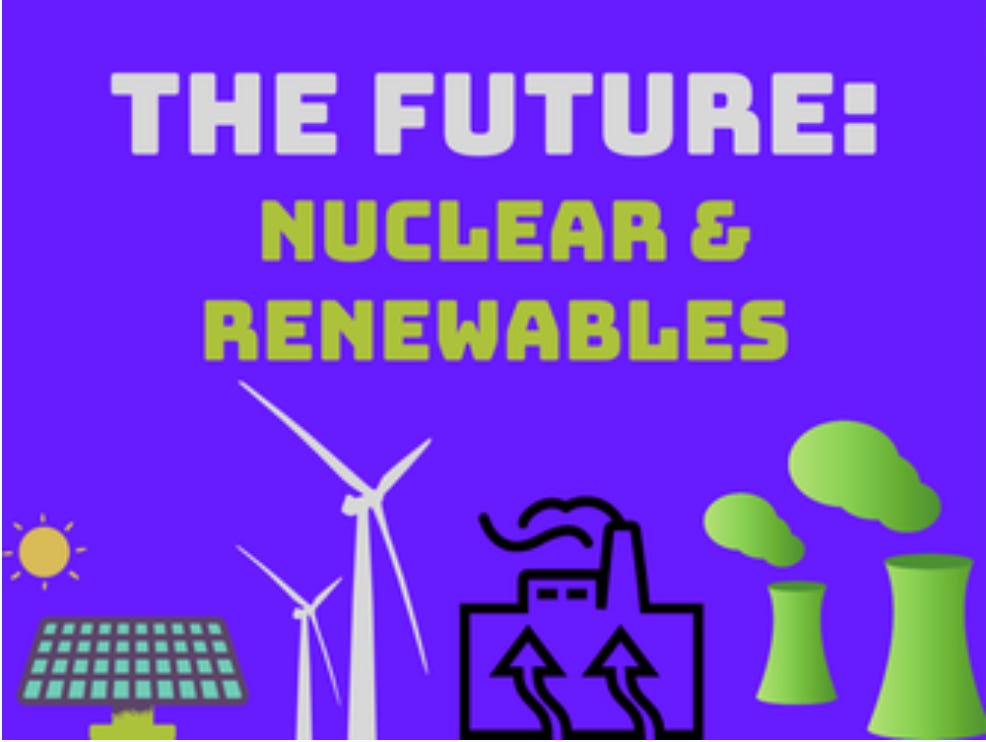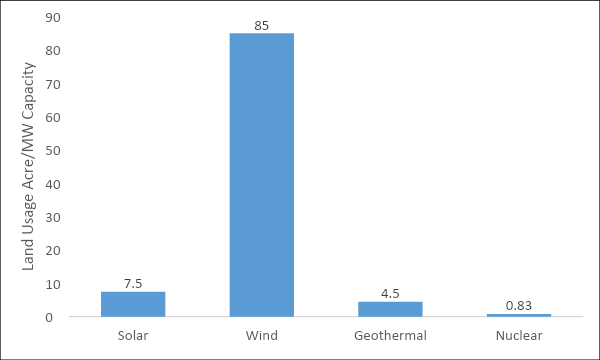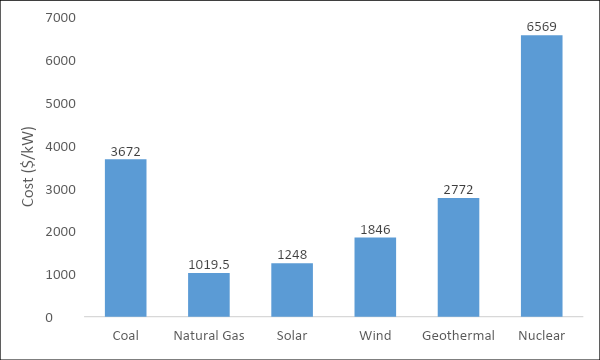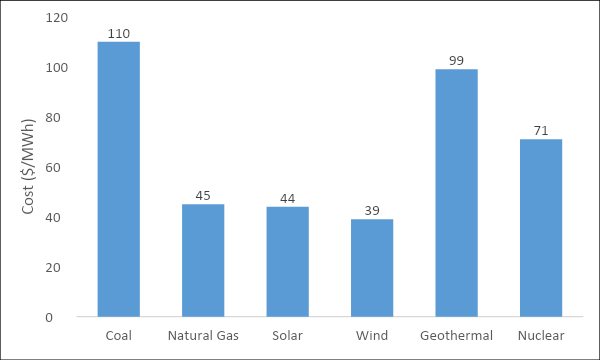How Nuclear Compares to Renewables
There are benefits and downsides to using nuclear energy instead of renewable energy sources such as solar, wind, or geothermal.
Artwork by Bailey Prasad
In 2020, the United States generated approximately 4.01 trillion kWh of energy. Of this energy produced, 60.6% was produced from non-renewable, fossil-fuel-emitting sources such as coal, petroleum, and natural gas. (1) With current estimates showing a rise in temperature of 2.5 to 10 degrees Fahrenheit over the next century, a transition to zero and low emission sources is at the forefront of energy policy. (2) Currently, the major sources of low-emission energy, also called clean energy, are nuclear electric power and renewable sources such as wind, solar and geothermal energy. Based on energy production numbers, nuclear energy accounts for 19.7%, wind for 8.4%, solar for 2.3%, and geothermal for 0.4% of the energy produced in 2020. (1) Though a transition to clean energy is needed to stop the growing impacts of climate change, a plan for taking the necessary steps to get there is easier said than done.
While renewable energy sources provide clean energy, they currently lack the technical capability for complete reliance on them. Wind and solar can provide nearly endless clean energy to the grid, but only under prime production conditions. For wind, areas like the Midwest or offshore (wind farms in the ocean) are ideal due to large flat areas with a steady wind flow. (3) Solar has the same requirement regarding space but additionally requires sun for most of the year. (4) These limitations create fluctuations in energy that would be provided to the grid, create seasonal energy production differences, and would require infrastructure to be put in place to transport energy to areas where these technologies are not feasible. (5) Geothermal power has similar geographic restrictions as there is not an infinite number of hot patches in the ground to harness the energy, creating limitations on where plants could be created. (6)
Nuclear power is considered a promising choice for the future of energy because of its high production capability, small use of land, and zero emissions from energy production. Much like solar, wind, and geothermal, nuclear, too, has limitations that leave some wary of adopting it as a primary energy source. Firstly, nuclear plants are extremely expensive to construct due to the specialized reactors needed, and materials needed for proper shielding and housing of the reactors. Likewise, the unpredictable time needed for licensing approval and construction delays makes nuclear plants one of the most difficult production methods to initiate. (7)
Nuclear energy and renewable sources all show promise for the next generation of energy, but it is hard to say that one source alone could reproduce the reliability of the fossil fuel sources we use today. This series of articles will give a brief look at the current state of each source, followed by an analysis of the technical capabilities and economic feasibility of each.
Current Status of Solar, Geothermal and Wind, and Nuclear Energy
Solar energy has been a favorite among renewable energy sources because once the infrastructure is in place it only requires sunlight, a free and relatively infinite source. Furthermore, solar energy is not associated with many of the environmental damages that come with fossil fuels such as air pollution and destruction of the land. (8) Currently, the United States has an installed utility-scale capacity of 97.3 gigawatts electric from solar alone with an average land usage of 5 to 10 acres per MW. Estimates show that a total of 22,000 square miles of land used for solar farms could be enough to power the entirety of the United States. (9,10) Aside from grid-scale energy production, solar energy can also be used for a variety of industrial applications such as powering streetlights, equipment on spacecraft and satellites, and individual houses. (8)
Geothermal energy uses heat from the earth to produce steam and rotate a turbine. The heat required for geothermal energy comes from hot springs close to the Earth’s surface, or from reservoirs up to 2 miles underground. Currently, 7 states have geothermal power plants, with the majority being in California. (11) The United States has an installed capacity of approximately 3.8 GW with the average land usage being 1 to 8 acres per MW. (12,13) Aside from geothermal energy production, geothermal energy is commonly harnessed for use in heating homes or buildings. (11)
Wind energy, another zero-emission source, uses turbines with large fins to catch the wind and spin the turbine for energy production. Presently, 40 states use wind energy totaling a capacity of 122 GW. The average production capacity of a wind turbine is 2.55 MW and requires 85 acres per megawatt capacity for large wind farms. Wind energy production is most efficient in the Midwest and offshore, areas of high wind and large amounts of space, but are viable anywhere with average wind speeds over 6 m/s. (14)
Nuclear energy makes use of the fissile properties of uranium or plutonium to create a large amount of heat energy. This heat energy can then be used to generate steam and power a turbine for electricity generation. (15) As of 2020, the United States had 94 active nuclear reactors in 28 states with a generation capacity of 96GW, and on average requires .83 acres per MW. (16,17) Nuclear power plants can be scaled to include multiple reactors in their design, with 32 of the active plants containing 2 reactors, and 3 plants having 3 reactors. (16)
Figure 1: Land usage per MW capacity by energy source
Technical Limitations of Solar, Wind, Geothermal, and Nuclear Power
One of the primary challenges with large-scale implementation of wind and solar energy is seasonal and geographic fluctuation in generation capacity. For solar, November to February sees the least average sunlight in the United States, and total produced energy from these months in 2020 was an average value of 5.272 TWh across the United States. By contrast, in the summer months of May to August, the average was 9.455 TWh. A similar trend can be seen with wind energy as the winter months produce approximately 25% more energy than the summer months. (18) Looking at local regions of energy production, the Northwest and California have peak wind energy production in the summer months while the Midwest and New England produce the most wind energy from November to March. (19) These trends lead to an average capacity factor for solar and wind in the United States of 25% and 35% respectively. (20) Currently, the grid can receive constant generation from fossil fuel sources therefore, seasonal and geographical fluctuation is of no concern. Utilizing wind or solar as a primary energy production method would require critical changes to be made to the grid to account for these fluctuations, including energy storage systems and backup energy production methods. (4)
Furthermore, new means of grid-scale energy transportation would need to be put in place to allow for areas of lower production from wind and solar to receive sufficient energy. Both wind and solar farms are most commonly constructed in isolated areas far from cities, consequently, transmission from the farms to cities and residential areas would require new transmission lines to be put in place. (21) Furthermore, the current energy grid in the United States is made up of several individual “interconnections” and the transmission between them would not currently be capable of transmitting large quantities of energy from coast to coast. (22) A recent study from the National Renewable Energy Lab shows that if no improvements to current transmission are made, a transition to renewable energy sources would incur 15.5% of energy capacity wasted due to the inability to transport the energy. Proposed transmission projects are estimated to significantly reduce this waste and the costs associated with implanting more wind and solar into the grid. (21)
Geothermal energy is not widely used at the grid level due to the strict geographic and infrastructural needs for the plants to be efficient. While there is geothermal energy at almost every location within the earth’s core, for geothermal energy to be cost-efficient it must be close enough to the surface that infrastructure costs can remain low. Furthermore, many locations where there are suitable hot pockets within the core, are tectonically active, presenting the constant risk of infrastructure damage by earthquakes or volcanic eruptions. While geothermal electric power may not be viable on a country-wide scale, geothermal heating can be used as an alternative to oil for heating homes and buildings at almost any location. Using the hot water harnessed from the ground and transferring its heat energy to the air within the building is cost-effective and is not a source of greenhouse gas emissions. The main drawback of geothermal heating is the difficulty associated with transporting heated water or steam. Since the hot patches in the earth are not infinite, there would have to be main geothermal facilities to extract this heat and then transport it, and the farther it travels from the plant the more heat it loses. Along with this, geothermal is not a truly renewable energy source. While there is an abundance of heat energy in the earth’s core, eventually, hot patches closer to the surface of the earth could run dry rendering the infrastructure created useless. (6)
While nuclear power thrives in providing clean energy in large amounts, the primary disadvantages are the lack of knowledge in how to properly dispose of the radioactive products after the reaction and establishing the infrastructure. Currently, the United States Department of Energy is liable for all used fuel associated with nuclear reactors, but there is no official plan in place for the long-term disposal of nuclear fuel. The radioactive material is sealed and stored at storage sites across 34 states, but due to the hazards and environmental damage associated with these materials, a fixed disposal method has not yet been determined. (7) In terms of building a nuclear plant, on average it takes 6 to 7 years from start to finish, assuming minimal construction delays and licensing approval, either of which could add multiple years and millions of dollars in additional costs. Moreover, The licensing of a nuclear plant involves a rigorous design review, consideration of plant location, and a public safety evaluation, all of which may total up to 5 years creating significant difficulty in the creation of nuclear plants. (23)
Economic Feasibility of Renewable and Nuclear Energy
While the technical capability of a given source is important to ensure that it can provide sufficient energy to meet the needs of the grid, these technologies would likely never be implemented unless they are profitable, or at least provide a return on their investment. The cost of energy from a given source is typically described by two statistics, the overnight cost or the Levelized cost. The overnight cost describes how much a source costs per unit energy capacity if it was all paid at once. The Levelized cost takes an average over the lifetime of the plant to give an estimate of the cost per unit of energy. Both statistics will be used here as overnight cost gives a better view of the capital cost of a plant, while Levelized cost better explains the cost of operation, maintenance, and fuel. Data for the overnight and Levelized cost by energy source is summarized in figures 2 and 3, and capacity factors for each source are in table 1 below:
Table 1: Capacity factors by energy production source (24)
Coal: 47.5%. Solar: 24.5% Geothermal: 90%
Natural Gas: 56.8% Wind: 34.8% Nuclear: 93.5%
Figure 2: Overnight cost per kW of common energy production sources. Data adapted from EIA cost outlook 2021 (25)
Figure 3: Levelized cost per MWh of common energy sources. Data adapted from IEA energy generation cost projections 2020 (26)
To provide a complete analysis of the economic feasibility of a source it is important to consider both cost and capacity factors. To first comment on geothermal, it has a high capacity factor compared to other renewable sources, and though the cost is higher the high capacity factor makes geothermal a reasonable source compared to the other renewables. As seen in the figures above, coal seems like an expensive source of energy compared to some renewable energy sources, but two things must be considered in this evaluation: First, the costs above include the cost of operation but also building the infrastructure of a plant. For coal this infrastructure is already in place therefore, costs would be reduced to routine maintenance and fuel. Secondly, the capacity factor of coal is significantly higher than wind, and almost double that of solar. This means to match the output of a 1 MW coal plant you would need two 1 MW solar farms, thereby doubling the cost. A similar argument can be made for nuclear power. It has the highest overnight cost of all sources, but also boasts a significantly higher capacity factor than any other source. To match the capacity of a nuclear plant 2 coal plants or more than 3 solar farms would be needed. Furthermore, nuclear plants can have maintenance done to extend the average estimated lifetime by almost 20 years, reducing the Levelized cost to approximately $30/MWh. (26) This makes nuclear power, at least economically, the most viable choice for a primary energy production method.
To further elaborate on the issue of capacity factor regarding solar and wind, a primary reason for the low-capacity factor is the seasonal production mentioned previously. If solar or wind were chosen as a primary energy source, they would need pairing with energy storage systems to save energy during prime production seasons and ensure a surplus of energy available to the grid in times of low production. With solar and wind farms often built in large, open areas, the most common energy storage method, pumped hydroelectric storage, is not very reasonable as this would cause additional infrastructure needed for transmission of generated electricity. This leaves on-site battery storage as a primary option for coupling with wind or solar. Current estimates on the overnight cost of battery storage amount to $1165/kW. (25) If 3 solar farms were needed to match the capacity of a nuclear plant, and energy had to be stored to be used in seasonal energy droughts, this would result in 3 storage systems needing to be made, increasing the total cost twofold.
Conclusions
In a combined analysis of both the technical and economic aspects of renewable sources and nuclear energy, there are distinct challenges ahead in the world of engineering to make the critical decision of the future of energy production. Renewable sources such as wind and solar provide cheap and clean energy to the grid, but lack year-round production capacity creating the need for energy storage systems, and unsteady energy flow to the grid. While geothermal is economically a fair choice, its geographical limitations prevent scalability to the extent of powering an entire country. In terms of the energy production method that is most prepared to match the technical capabilities and economic benefits of fossil fuels, nuclear energy is the frontrunner. Nuclear plants require significantly less land to create and can be run around the clock to meet the demands of the grid. Additionally, the expensive establishment costs can be outweighed by life-extending maintenance allowing Levelized costs to be lower than any other source. Although nuclear energy dominates the sectors of technology and economics, it needs work on the policy side to make a swift transition. Current reactor licensing and construction times create doubt as to whether nuclear energy could become the primary production source, but government rules and regulations on reactor construction, standardized safety features and designs, and a fixed disposal method of waste could expedite this process.
While nuclear power shows the most promise as of now, solar and wind and even advanced fossil fuel technologies should not be ruled out. Research and development into energy storage technology and more efficient solar panels and wind turbines could lower costs significantly enough to make these feasible choices for grid-scale energy. Along with this, solar and wind could be used in their prime seasons coupled with small-scale nuclear power in the offseason to provide the consistent energy needed. Fossil fuel sources such as natural gas and coal may be environmentally harmful when used alone, but carbon capture technology shows promising results that these emissions can be reduced, or even renewed. While the future of energy production may currently be unknown, the technologies available today show that there are multiple roots that can be taken to reach a clean energy future.
References
[1] Frequently Asked Questions (FAQs) - U.S. Energy Information Administration (EIA).
https://www.eia.gov/tools/faqs/faq.php?id=427&t=3.
[2] Jackson, R. The Effects of Climate Change. Climate Change: Vital Signs of the Planet. https://climate.nasa.gov/effects.
[3] Where wind power is harnessed - U.S. Energy Information Administration (EIA).
https://www.eia.gov/energyexplained/wind/where-wind-power-is-harnessed.php.
[4] Lehtola, T. Technical Challenges in the Application of Renewable Energy. (2020).
[5] Advantages and Challenges of Wind Energy. Energy.gov https://www.energy.gov/eere/wind/advantages-and-challenges-wind-energy.
[6] Challenges | Geothermal Electricity. https://sites.lafayette.edu/egrs352-sp14-geothermal/general-information/challenges/.
[7] Advantages and Challenges of Nuclear Energy. Energy.gov https://www.energy.gov/ne/articles/advantages-and-challenges-nuclear-energy.
[8] Sampaio, P. G. V. & González, M. O. A. Photovoltaic solar energy: Conceptual framework. Renewable and Sustainable Energy Reviews 74, 590–601 (2017).
[9] Solar Energy in the United States. Energy.gov https://www.energy.gov/eere/solar/solar-energy-united-states.
[10] Ong, S. Land Use Requirements For Solar Plants In The United States. NREL (2013).
[11] Use of geothermal energy - U.S. Energy Information Administration (EIA).
https://www.eia.gov/energyexplained/geothermal/use-of-geothermal-energy.php.
[12] Geothermal Energy Factsheet | Center for Sustainable Systems. https://css.umich.edu/factsheets/geothermal-energy-factsheet.
[13] Geothermal Power Plants — Minimizing Land Use and Impact | Department of Energy. https://www.energy.gov/eere/geothermal/geothermal-power-plants-minimizing-land-use-and-impact.
[14] Wind Energy Factsheet | Center for Sustainable Systems. https://css.umich.edu/factsheets/wind-energy-factsheet.
[15] Nuclear Power Basics. https://nuclear.gepower.com/nuclear-power-basics.
[16] Land Needs for Wind, Solar Dwarf Nuclear Plant’s Footprint. Nuclear Energy Institute. https://www.nei.org/news/2015/land-needs-for-wind-solar-dwarf-nuclear-plants.
[17] U.S. nuclear industry - U.S. Energy Information Administration (EIA). https://www.eia.gov/energyexplained/nuclear/us-nuclear-industry.php.
[18] Electric Power Monthly - U.S. Energy Information Administration (EIA). https://www.eia.gov/electricity/monthly/epm_table_grapher.php?t=epmt_1_01_a.
[19] Wind generation seasonal patterns vary across the United States - Today in Energy - U.S. Energy Information Administration (EIA). https://www.eia.gov/todayinenergy/detail.php?id=20112.
[20] Electric Power Monthly - U.S. Energy Information Administration (EIA). https://www.eia.gov/electricity/monthly/epm_table_grapher.php?t=epmt_6_07_b.
[21] Report Shows New Transmission Can Help Wind Energy Supply a Third of U.S. Electricity. Energy.gov. https://www.energy.gov/eere/articles/report-shows-new-transmission-can-help-wind-energy-supply-third-us-electricity.
[22] Learn More About Interconnections. Energy.gov https://www.energy.gov/oe/services/electricity-policy-coordination-and-implementation/transmission-planning/recovery-act-0.
[23] Process of Building Nuclear Power Plant. http://large.stanford.edu/courses/2017/ph241/park-k2/.
[24] What is Generation Capacity? Energy.gov https://www.energy.gov/ne/articles/what-generation-capacity.
[25] Cost and Performance Characteristics of New Generating Technologies, Annual Energy Outlook 2021. (U.S Energy Information Administration, 2021).
[26] Projected Costs of Generating Electricity 2020 – Analysis. IEA https://www.iea.org/reports/projected-costs-of-generating-electricity-2020.





